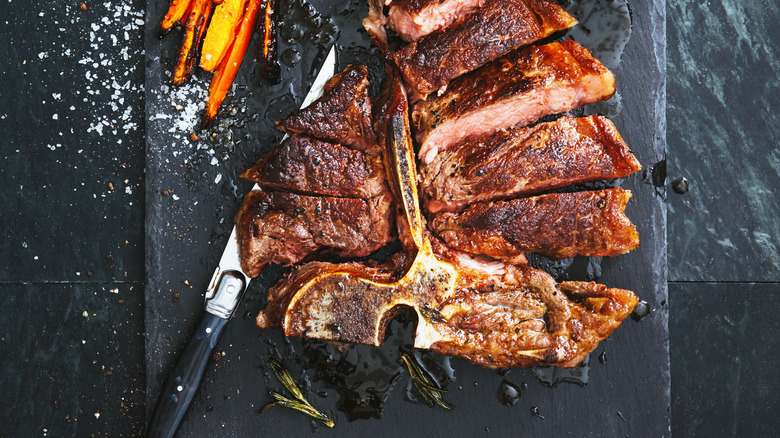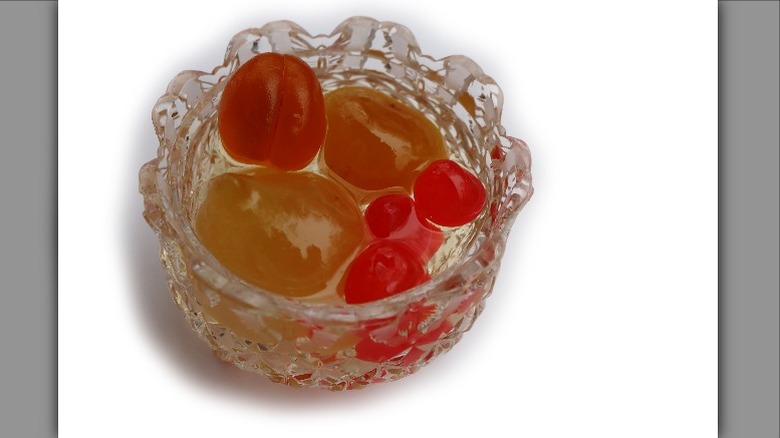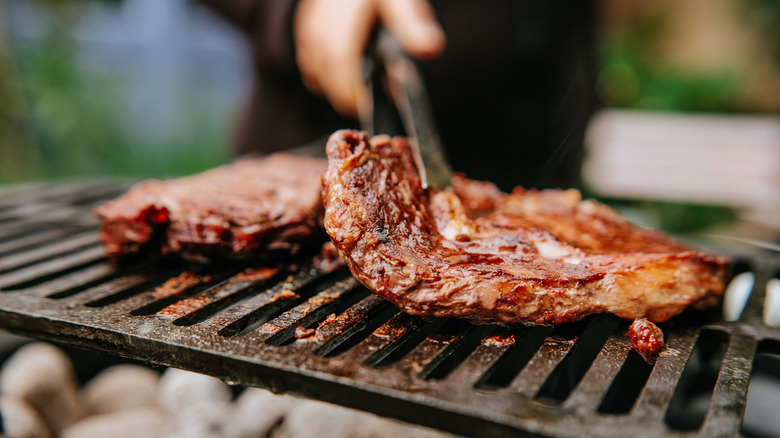The Italian Condiment Your Grilled Meats Are Begging For
If you have mastered how to grill steak perfectly every time, it's time to learn how to serve it with the perfect condiment. Searing meat over an open fire until a crusty exterior develops, produces juicy, succulent, and delicious flavors that are pretty amazing as-is, but if you're not topping it off with a spoonful or two of the Italian condiment known as mostarda, you're missing out.
Mostarda will give your mouth a party of yin and yang flavors, as it combines sweet fresh and dried fruit in a bath of sharp mustard, vinegar, and spices that have been reduced into a syrupy liquid. The fruit transforms into a chutney-like consistency as it cooks and marinates in this mix. The end product offers a balance of sweet and savory with fruity and spicy notes.
Traditionally served with charcuterie boards made up of cured meats and cheeses, mostarda lightens and brightens other rich, fatty foods. When you finish your grilled steak, chicken, pork, or even that holiday turkey with some mostarda, it acts as the perfect contrast, and adds a variety of textures with both chewy and soft bites of fruit. It's even easy to make your own at home — the wait time is the only real hurdle.
Making mostarda requires patience and planning
To make traditional mostarda, you'll need to plan ahead. While the cooking itself is not difficult or labor intensive, it's a multi-day commitment. On the first day, cut up whatever fruits you want to use — both fresh and dried. Sprinkle the fresh fruits with sugar so they release their juices. For dried fruits, you will want to put them in a separate pot on the stovetop with just enough water to cover them and simmer for 15 minutes. This will allow the pieces to rehydrate. Remove from the heat and cool before mixing the dried fruit (and the liquid it simmered in) with the macerating fresh fruit. Allow the combined fruits and juices to sit for about two hours at room temperature and then place this fruity mixture in the fridge for 24 hours.
On the second day, drain your fruits and then simmer the liquid on the stovetop until it reduces and thickens into a syrup consistency. Soak the fruit in the resulting syrup and place in the fridge for another 24 hours. Repeat this draining/reduction/resoaking process again on the third day, and then on the fourth day, you want to pour the fruit, the syrup, along with the mustard, vinegar, and other spices into a pot to simmer. Allow it to cool and refrigerate, and voilà, you are ready to use it with your favorite grilled meats.
Mostarda meat combinations
The more vinegar and dry mustard you add, the tangier your mostarda will be, so if you are new to this condiment start small using a 1:2 ratio of dry mustard to vinegar to start. The mustard is key. It serves as a flavor enhancer that adds a boost to the syrup that will ultimately coat the surface of your smoky, charred cuts of grilled meat.
If you need some pairing inspiration, try grilling a pork loin or duck breast, and make an apple pepper mostarda to go along with it. The sweetness of the apples will echo the sweetness that both these meats possess while the pepper gives it a little punch. Peaches are also a great fresh fruit to include in your mostarda when making pork. Pair your peaches with dried apricots or some crystallized ginger for a little sweet heat. A cranberry mostarda is lovely with grilled chicken or turkey and if you are searing up some skirt steak in the fall, make a pomegranate mostarda. This sweet addition rounds out the savory taste of the beef.
Mostarda has a long shelf life – a month or longer, provided you refrigerate and store it in an airtight jar. Make a big batch and use it up throughout the warm summer months, or save a little to break out when you have an abnormally warm fall day and want to fire up the grill.


